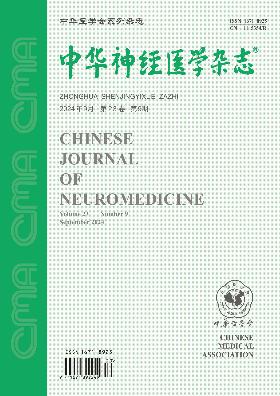Swirl sign and black hole sign on CT scanning in predicting early hematoma expansion in intracerebral hemorrhage: a comparative study
Q4 Medicine
引用次数: 0
Abstract
Objective To compare the predictive values of swirl sign and black hole sign on CT scanning in early hematoma expansion in spontaneous intracerebral hemorrhage (SICH) patients. Methods Two hundred and ten firstly diagnosed SICH patients, admitted to our hospital from January 2012 to December 2018, were enrolled in the study. All patients were divided into hematoma expansion and non-hematoma expansion group according to whether early hematoma expansion appeared; and they were also divided into positive imaging sign group and negative imaging sign group according to whether imaging signs appeared; the clinical and imaging data were compared between these groups, respectively. The accuracies of swirl sign and black hole sign in predicting early hematoma expansion were analyzed using receiver operator characteristic (ROC) curve. Multivariate Logistic regression analysis was performed to determine the independent risk factors for early hematoma expansion. Results (1) In the 57 patients with early hematoma expansion, 21 (36.8%) had swirl sign, and 17 (29.8%) had black hole sign; in the 153 patients without hematoma expansion, 12 (7.8%) had swirl sign and 22 (14.4%) had black hole sign; the differences between the two groups were statistically significant (P 0.05); the hematoma volume in patients with black hole sign (n=39) was significantly increased as compared with that in patients without black hole sign (n=171, P 0.05). (3) The areas under ROC curve of swirl sign, black hole sign, and "swirl sign combined with black hole sign" were 0.645, 0.577, and 0.570, respectively. (4) Multivariate Logistic regression analysis showed that admission systolic blood pressure, swirl sign and black hole sign were independent risk factors for early hematoma expansion (P<0.05). Conclusion In comparison to black hole sign and "swirl sign combined with black hole sign" , the swirl sign has higher predictive value in early hematoma expansion in ICH patients. Key words: Spontaneous intracerebral hemorrhage; Hematoma expansion; Swirl sign; Black hole signCT旋流征与黑洞征预测脑出血早期血肿扩张的比较研究
目的比较CT旋流征象与黑洞征象对自发性脑出血早期血肿扩张的预测价值。方法选取2012年1月至2018年12月我院收治的210例首发颅内出血患者作为研究对象。根据早期是否出现血肿扩张分为血肿扩张组和非血肿扩张组;并根据是否出现影像学征象分为阳性影像学征象组和阴性影像学征象组;比较两组患者的临床及影像学资料。采用ROC曲线分析漩涡征象和黑洞征象预测早期血肿扩张的准确性。采用多因素Logistic回归分析确定早期血肿扩张的独立危险因素。结果(1)57例早期血肿扩张患者中,漩涡征21例(36.8%),黑洞征17例(29.8%);153例无血肿扩张的患者中,漩涡征12例(7.8%),黑洞征22例(14.4%);两组间差异有统计学意义(p0.05);有黑洞征患者血肿体积(n=39)较无黑洞征患者显著增加(n=171, P < 0.05)。(3)漩涡标志、黑洞标志和“漩涡标志结合黑洞标志”的ROC曲线下面积分别为0.645、0.577和0.570。(4)多因素Logistic回归分析显示,入院收缩压、漩涡征、黑洞征是早期血肿扩张的独立危险因素(P<0.05)。结论与黑洞征象和“漩涡征象合并黑洞征象”相比,漩涡征象对脑出血患者早期血肿扩张具有更高的预测价值。关键词:自发性脑出血;血肿扩张;漩涡的迹象;黑洞标志
本文章由计算机程序翻译,如有差异,请以英文原文为准。
求助全文
约1分钟内获得全文
求助全文
来源期刊

中华神经医学杂志
Psychology-Neuropsychology and Physiological Psychology
CiteScore
0.30
自引率
0.00%
发文量
6272
期刊介绍:
 求助内容:
求助内容: 应助结果提醒方式:
应助结果提醒方式:


